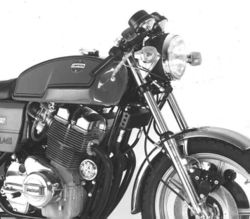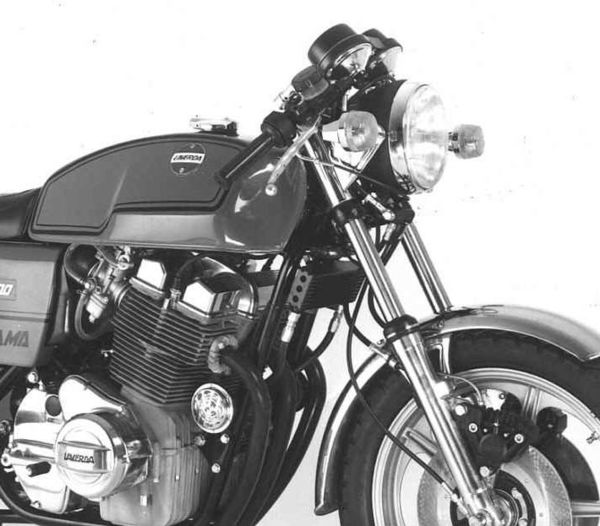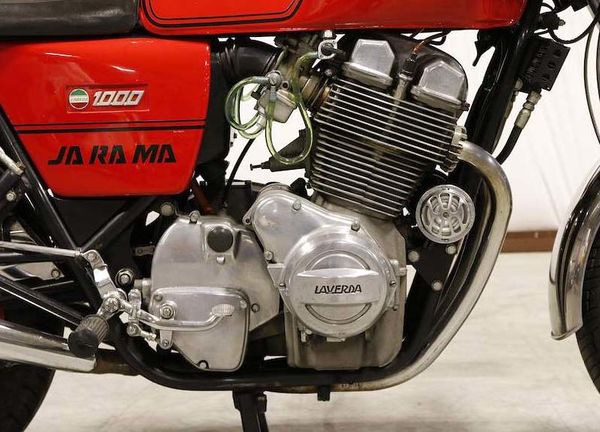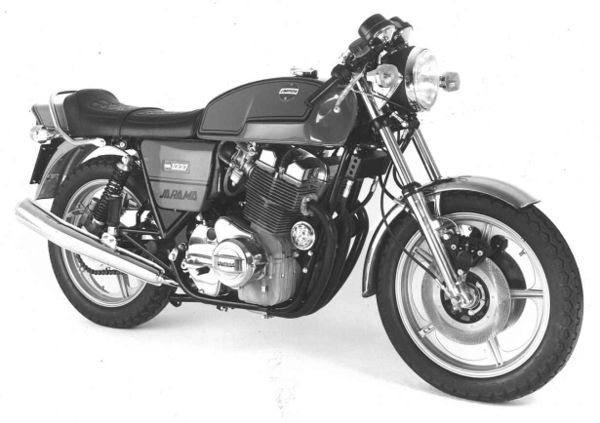Laverda 1000 Jarama
 |
|
| Laverda 1000 Jarama | |
| Manufacturer | |
|---|---|
| Production | 1978 |
| Engine | Four stroke, transverse three cylinder, DOHC, 2 valve per cylinder. |
| Compression ratio | 9.0:1 |
| Top Speed | 198 km/h / 123 mph |
| Ignition | Bosch electronic |
| Transmission | 5 Speed |
| Suspension | Front: Telescopic forks Rear: Swinging fork |
| Brakes | Front: 2x 280mm discs 2 piston calipers Rear: Single 280mm disc 1 piston caliper |
| Front Tire | 3.25 H19 |
| Rear Tire | 4.00 H18 |
| Weight | 214 kg / 471.3 lbs (dry), |
| Fuel Capacity | 20.5 Liters / 5.4 US gal |
| Manuals | Service Manual |
It could reach a top speed of 198 km/h / 123 mph.
Engine[edit | edit source]
The engine was a Air cooled cooled Four stroke, transverse three cylinder, DOHC, 2 valve per cylinder.. The engine featured a 9.0:1 compression ratio.
Chassis[edit | edit source]
It came with a 3.25 H19 front tire and a 4.00 H18 rear tire. Stopping was achieved via 2x 280mm discs 2 piston calipers in the front and a Single 280mm disc 1 piston caliper in the rear. The front suspension was a Telescopic forks while the rear was equipped with a Swinging fork. The 1000 Jarama was fitted with a 20.5 Liters / 5.4 US gal fuel tank. The bike weighed just 214 kg / 471.3 lbs.
Photos[edit | edit source]
Overview[edit | edit source]
Laverda 1000 Jarama
Blessed with one of the most evocative names in motorcycling history, the Jota
was the bike that really put Laverda on the global map. Its direct progenitor
was the tuned version of the Italian firm's 3C triple - the 3C(E) - developed
for production racing by the UK importer, Slater Brothers. The production "180"
Jota was both more highly tuned and quicker, its 140mph top speed making it the
world's fastest road-going production motorcycle at the time of its launch for
1976. It was also pretty handy on the racetrack, winning the UK's Avon
championship in 1976 and 1978 in the hands of Pete Davies. Few major changes
were made to the Jota prior to 1982 when a heavily revised version was
introduced, complete with a 120-degree crankshaft.
The Jarama first saw the light of day in model year 1978 as the North American version of the 3CL, the successor of the original 3C, and it stayed through 1980. Each came equipped with a left-foot gearshift, right brake, indicators, side reflectors, and slightly lower gearing. The Jarama name was taken from Spain as was Jota this time instead of a dance, a racetrack outside Madrid. Perhaps it was chosen by Roger Slater as a twin to his chosen Jota. The bright red or green (only) black pinstriped 3CL/Jarama was a strong, glorious motorcycle pressing all the right buttons, making all the right noises, but with slightly less top end than the Jota. More to the point, though, it wasn't called Jota and it didn't sell well enough in its intended market. And thus most were shipped back to the UK and into other markets. Some were converted to Jota specification, sometimes to be nicknamed "Jarotas."
| Make Model | Laverda 1000 Jarama |
|---|---|
| Year | 1978 |
| Engine Type | Four stroke, transverse three cylinder, DOHC, 2 valve per cylinder. |
| Displacement | 980 cc / 59.8 cu-in |
| Bore X Stroke | 75 x 74 mm |
| Cooling System | Air cooled |
| Compression | 9.0:1 |
| Induction | 3x 32mm Dell'Orto PHF carburetors |
| Ignition | Bosch electronic |
| Starting | Electric |
| Max Power | 78 hp / 56.9 kW @ 7250 rpm |
| Max Torque | 86 Nm / 63.4 lb-ft @ 5000 rpm |
| Transmission | 5 Speed |
| Final Drive | Chain |
| Front Suspension | Telescopic forks |
| Rear Suspension | Swinging fork |
| Front Brakes | 2x 280mm discs 2 piston calipers |
| Rear Brakes | Single 280mm disc 1 piston caliper |
| Front Tire | 3.25 H19 |
| Rear Tire | 4.00 H18 |
| Dry Weight | 214 kg / 471.3 lbs |
| Fuel Capacity | 20.5 Liters / 5.4 US gal |
| Consumption Average | 40 mpg |
| Top Speed | 198 km/h / 123 mph |


